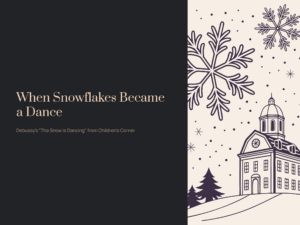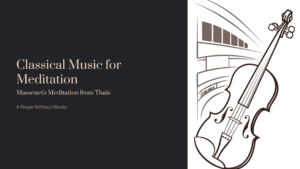Table of Contents
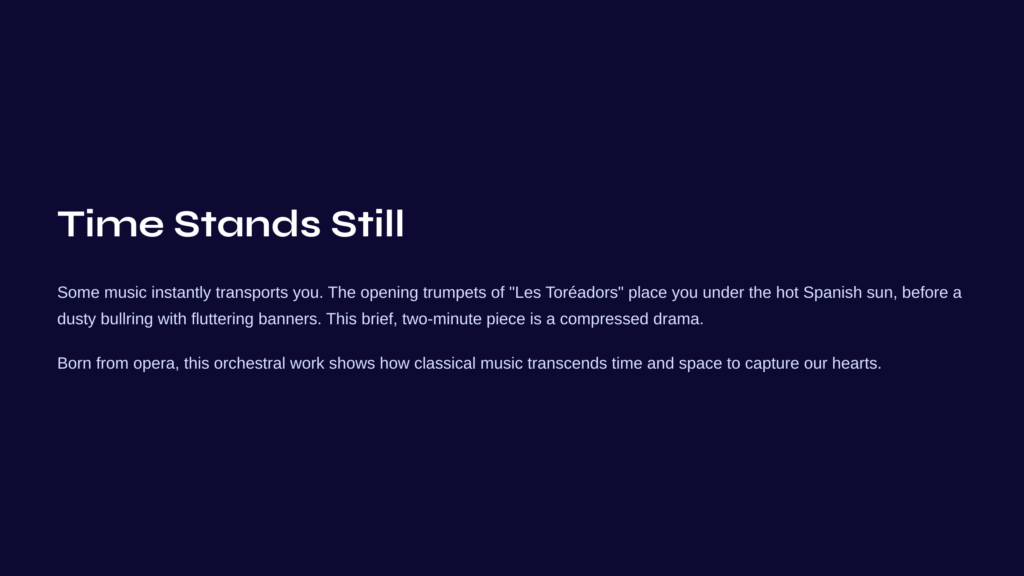
In That Moment, Time Seemed to Stand Still
Some music transports us to a specific time and place with just its opening measures. The moment trumpets and horns blaze forth in unison, I find myself standing beneath the scorching sun of southern Spain. Before a dusty bullring, colorful banners flutter in the wind, and the sound of drums echoes from afar. This is precisely the scene painted by Georges Bizet’s “Les Toréadors.”
Within this brief two-minute composition lies a compressed drama. Born on the operatic stage but now more beloved as an independent orchestral work, this piece perfectly demonstrates how classical music transcends time and space to capture our hearts.
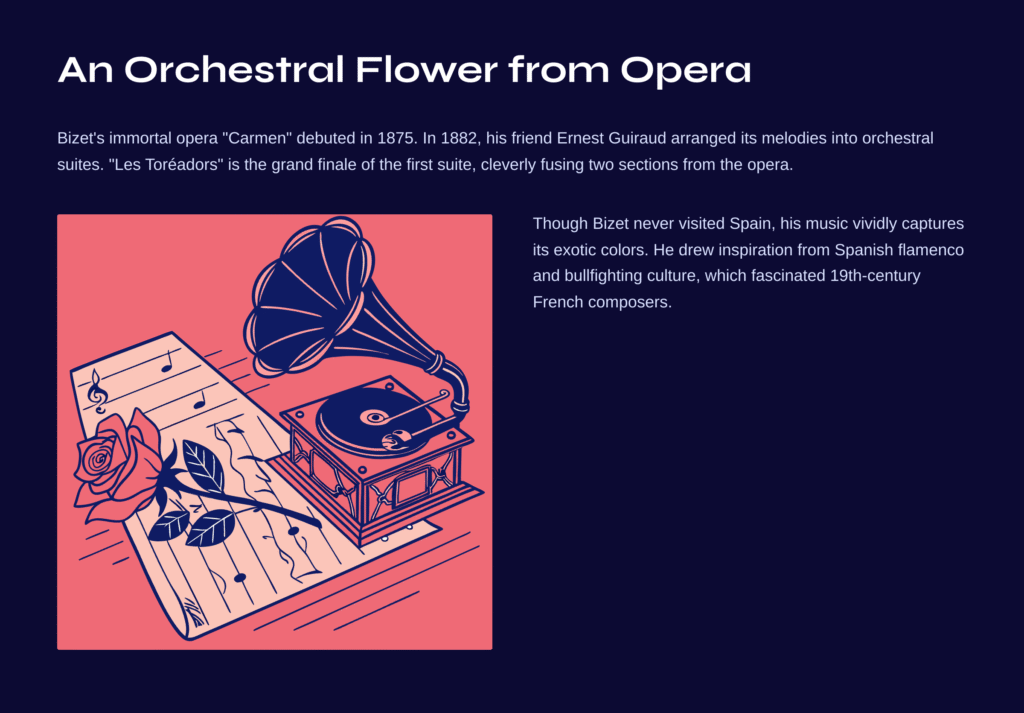
An Orchestral Flower Blooming from Opera
In 1875, Bizet brought forth the immortal opera “Carmen.” Ironically, he passed away that same year without witnessing his work’s success. Seven years later, in 1882, Bizet’s friend Ernest Guiraud gathered the opera’s beautiful melodies into two orchestral suites. “Les Toréadors” serves as the grand finale of the first suite.
This piece actually represents a clever fusion of two separate sections from the opera. The toreador theme from the Act I prelude merges with the march from Act IV, when Escamillo makes his entrance to the bullring. Guiraud maintained Bizet’s original orchestration while rearranging the opera’s chronological order, creating what sounds like a complete symphonic poem.
Late 19th-century Europe was captivated by exotic flavors. Spanish flamenco and bullfighting culture provided infinite inspiration for French composers. Though Bizet never visited Spain, his imagination captured remarkably vivid Spanish colors in his music.
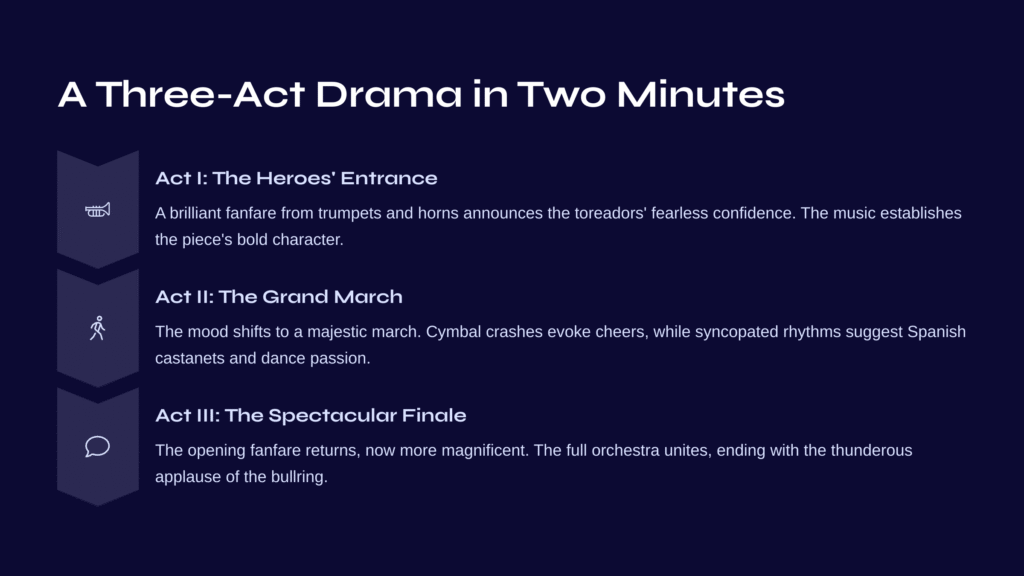
A Three-Act Drama Unfolding in 2 Minutes and 20 Seconds
Act I: The Heroes’ Entrance (0:00-0:35)
Trumpets and horns blaze forth in A major’s brilliant fanfare. Over the snare drum’s steady tremolo, the brass section boldly proclaims the toreador theme. This melody, simple yet memorable, embodies the toreador’s fearless confidence as if declaring “I am not afraid.”
Here we witness Bizet’s orchestration mastery. Beginning with brass unison, strings add rhythmic accompaniment while woodwinds provide colorful touches. Though merely 16 bars of introduction, it perfectly establishes the entire piece’s character.
Act II: The Grand March (0:35-1:40)
The atmosphere shifts. Lower strings and bassoons begin the broad, majestic march theme. This is that famous melody from Act IV when Escamillo enters the bullring. Each cymbal crash evokes spectators’ cheers, while upper woodwinds play syncopated rhythms reminiscent of Spanish castanets.
In this section, Bizet masterfully combines the march’s solemnity with Spanish dance passion. Above the stable 4/4 pulse, exciting syncopations dance while instrumental dialogues vividly portray the bullring’s complex, dynamic atmosphere.
Act III: The Spectacular Finale (1:40-2:20)
The opening fanfare returns, now far more brilliant and magnificent. The full orchestra unites to play the toreador theme while the piccolo adds sparkling ornaments in the high register. With powerful timpani strikes and a decisive A major conclusion, audiences experience the bullring’s thunderous applause and cheers.
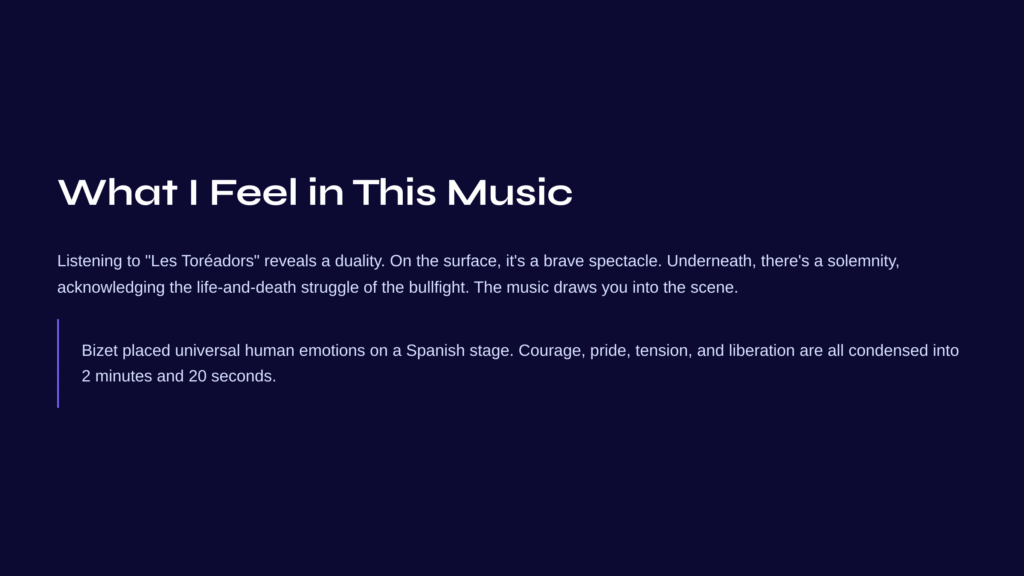
What I Feel in This Music
Whenever I listen to “Les Toréadors,” I sense a curious duality. On the surface lies brave, spectacular pageantry, yet underneath flows an undercurrent of solemnity. Bizet surely understood that bullfighting represents a life-and-death struggle.
As the music progresses, I’m increasingly drawn into the scene. During the fanfare, I feel part of the procession; during the march, I become one of thousands of spectators holding my breath. At the final climax, I experience catharsis as everything harmonizes into one.
This experience is possible because Bizet didn’t merely create “Spanish-style music” but placed universal human emotions on a Spanish stage. Courage, pride, tension, liberation—all perfectly condensed within 2 minutes and 20 seconds.
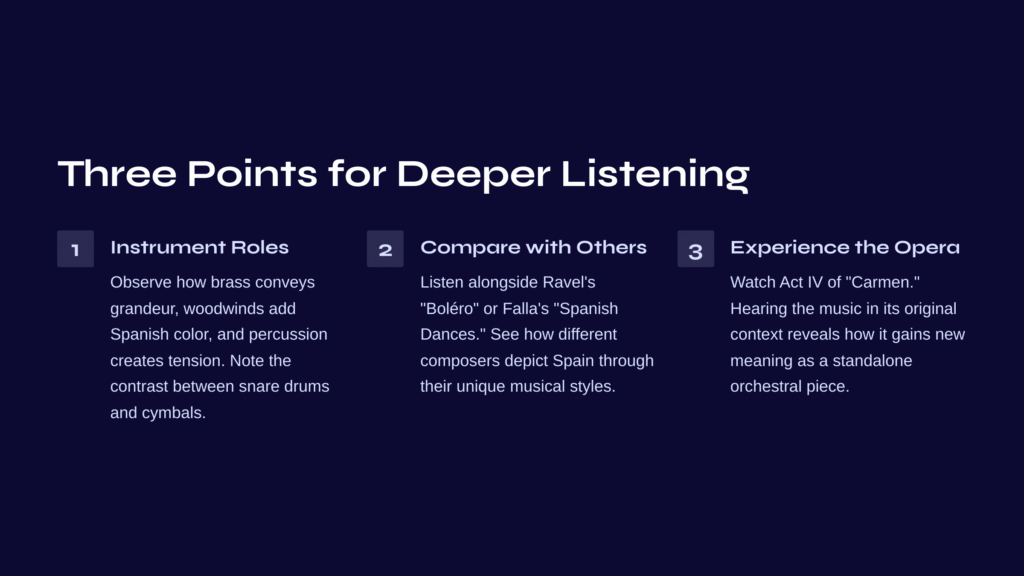
Three Points for Deeper Listening
First, observe each instrumental section’s role. Brass instruments convey the toreros’ grandeur, woodwinds provide Spanish coloring, and percussion creates dramatic tension. Pay special attention to the contrast between snare drum tremolo and cymbal crashes.
Second, compare this piece with other famous Spanish-flavored classical works. Listening alongside Ravel’s “Boléro” or Falla’s “Spanish Dances” reveals how each composer depicts Spain differently.
Third, if possible, experience the complete opera “Carmen.” Particularly after watching Act IV’s toreador entrance scene, hearing this orchestral version reveals how the same music gains new meaning in different contexts.
Music’s Magic That Transcends Time
After the music ends, I remain suspended in its afterglow. Though only two minutes long, it feels like returning from an extended journey. This is the power of true classical music—the magical ability to transport us beyond temporal and spatial boundaries.
Bizet’s “Les Toréadors” perfectly exemplifies this magic. The Spain imagined by a 19th-century French composer still vividly reaches us in the 21st century. Music truly transcends time. And in that transcendent moment, we all become united in shared emotion.
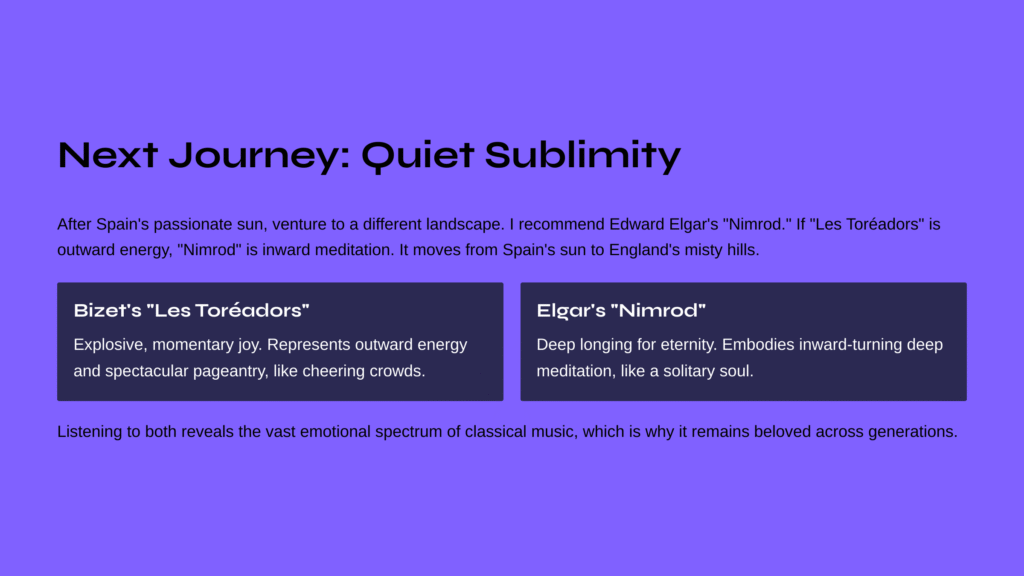
Next Journey: Into a World of Quiet Sublimity
After experiencing this passionate parade under the Spanish sun, why not venture into a completely different emotional landscape? I recommend Edward Elgar’s “Nimrod” from the “Enigma Variations.”
If Bizet’s “Les Toréadors” represents outward energy and spectacular pageantry, Elgar’s “Nimrod” embodies inward-turning deep meditation. From Spain’s blazing sun to England’s misty hills, from cheering crowds to a solitary soul standing alone. Though both are orchestral works, these two vastly different worlds await us.
“Nimrod” compresses humanity’s most sublime emotions into approximately 3 minutes and 30 seconds. The process of slow string melodies gradually building to a massive climax creates an experience like our souls slowly ascending to heaven. If “Les Toréadors” represents explosive momentary joy, “Nimrod” embodies deep longing for eternity.
Listening to both pieces consecutively reveals the vast emotional spectrum that classical music embraces. Sometimes with cheers and excitement, sometimes with quiet contemplation, music soothes our hearts. This is surely why classical music remains beloved across generations.
When the bullring dust settles and the cheers fade, the music continues resonating within our hearts. This is classical music’s gift to us.


